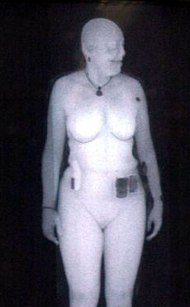Backscatter Full Body Scanners Can Be Defeated, Journal Article Finds
When the uproar over full body scanners finally hit a crescendo just before the Thanksgiving holiday, the two major reasons behind passenger anger were primarily privacy concerns and health fears over radiation.
But an article published online by The Journal of Transportation Security gives a third and seemingly more damning reason why one particular type of full body scanner shouldn't be in circulation: terrorists can easily defeat it.
In a 22-page, science-heavy article, researchers Leon Kaufman and Joseph W. Carlsondemonstrate why X-ray backscatter units can miss guns and blades but also explosives like PETN, used by last Christmas' underwear bomber, Umar Farouk Abdulmutallab.
The penetration not only distributes exposure throughout the body (this affecting the calculation of efective [sic] dose, which comprises a sum over all organs), but tends to diffuse the effects caused by contraband materials. Images can be made at low entrance exposures, but of very poor spatial resolution and S/N. The calculated signal excursions at high kilovoltage are so small as to make it doubtful that at any reasonable exposure levels density differences will be noticeable unless the contraband is packed thickly and with hard edges. Although the excursions are larger at low kilovoltage, they are still small and in the noise of the device’s operational limits. The eye is a good signal averager at certain spatial frequencies, but it is doubtful that an operator can be trained to detect these differences unless the material is hard-edged, not too large and regular shaped. Anatomic features and benign objects add structured noise that interferes with signal averaging. Figure 18 shows a widely-distributed backscatter image. On the left is a complete view of her torso, on the right, a section has been blacked out. While the breasts are easily recognized at right, without some prior knowledge of the subject, it would be hard to distinguish the increase of intensity in the superior part of her breasts from the natural gradients of the image.
It is very likely that a large (15–20 cm in diameter), irregularly-shaped, cm-thick pancake with beveled edges, taped to the abdomen, would be invisible to this technology, ironically, because of its large volume, since it is easily confused with normal anatomy. Thus, a third of a kilo of PETN, easily picked up in a competent pat down, would be missed by backscatter “high technology”. Forty grams of PETN, a purportedly dangerous amount, would fit in a 1.25 mm-thick pancake of the dimensions simulated here and be virtually invisible. Packed in a compact mode, say, a 1 cm×4 cm×5 cm brick, it would be detected.
The images are very sensitive to the presence of large pieces of high Z material, e.g., iron, but unless the spatial resolution is good, thin wires will be missed because of partial volume effects. It is also easy to see that an object such as a wire or a boxcutter blade, taped to the side of the body, or even a small gun in the same location, will be invisible. While there are technical means to mildly increase the conspicuity of a thick object in air, they are ineffective for thin objects such as blades when they are aligned close to the beam direction. (My emphasis)
While Kaufman and Carlson's journal article concentrates solely on backscatter technology, this isn't the first time that researchers have called into question the effectiveness of full body scanners in general. Back in March, Steve Lord, the Government Accountability Office's Director of Homeland Security and Justice Issues,testified before the Senate on the TSA's aggressive procurement of full body scanners and their effectiveness (.pdf).
"According to TSA’s threat assessment, terrorists have various techniques for concealing explosives on their persons, as was evident in Mr. Abdulmutallab’s attempted attack on December 25, when he concealed an explosive in his underwear," Lord said. "While TSA officials stated that the laboratory and operational testing of the AIT included placing explosive material in different locations on the body, it remains unclear whether the AIT would have been able to detect the weapon Mr. Abdulmutallab used in his attempted attack based on the preliminary TSA information we have received."
TSA currently deploys two types of full body scanners: the X-ray backscatter machines,manufactured by Rapiscan, and active millimeter wave machines, manufactured by L-3 Communications.
Kaufman and Carlson, however, didn't evaluate whether backscatter technology, which uses low-level X-rays to create a two-sided image of a passenger, poses any health risks. The TSA stresses emphatically that backscatter technology poses no radiation risks to the traveling public and provides links to independent studies confirming this.
